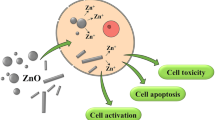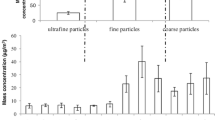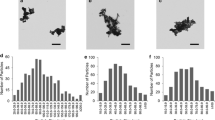Abstract
This is the first comprehensive study to evaluate the cytotoxicity, biochemical mechanisms of toxicity, and oxidative DNA damage caused by exposing human bronchoalveolar carcinoma-derived cells (A549) to 70 and 420 nm ZnO particles. Particles of either size significantly reduced cell viability in a dose- and time-dependent manner within a rather narrow dosage range. Particle mass-based dosimetry and particle-specific surface area-based dosimetry yielded two distinct patterns of cytotoxicity in both 70 and 420 nm ZnO particles. Elevated levels of reactive oxygen species (ROS) resulted in intracellular oxidative stress, lipid peroxidation, cell membrane leakage, and oxidative DNA damage. The protective effect of N-acetylcysteine on ZnO-induced cytotoxicity further implicated oxidative stress in the cytotoxicity. Free Zn2+ and metal impurities were not major contributors of ROS induction as indicated by limited free Zn2+ cytotoxicity, extent of Zn2+ dissociation in the cell culture medium, and inductively-coupled plasma-mass spectrometry metal analysis. We conclude that (1) exposure to both sizes of ZnO particles leads to dose- and time-dependent cytotoxicity reflected in oxidative stress, lipid peroxidation, cell membrane damage, and oxidative DNA damage, (2) ZnO particles exhibit a much steeper dose–response pattern unseen in other metal oxides, and (3) neither free Zn2+ nor metal impurity in the ZnO particle samples is the cause of cytotoxicity.












Similar content being viewed by others
References
Ai H, Bu Y, Han K (2003) Glycine-Zn+/Zn2+ and their hydrates: on the number of water molecules necessary to stabilize the zwitterionic glycine-Zn+/Zn2+ over the nonzwitterionic ones. J Chem Phys 118(24):10973–10985
Anish T, Michael EM, Craig JH, Brooke VH (2005) Effect of ideal, organic nanoparticles on the flow properties of linear polymers: non-Einstein-like behavior. Macromolecules 38(19):8000–8011
Bae SY, Seo HW (2004) Vertically aligned sulfur-doped ZnO nanowires synthesized via chemical vapor deposition. J Phys Chem B 108(17):5206–5210
Bai XD, Gao PX, Wang ZL, Wang EG (2003) Dual-mode mechanical resonance of individual ZnO nanobelts. Appl Phys Lett 82(26):4806–4808
Beckett WS, Chalupa DF, Pauly-Brown A, Speers DM, Stewart JC, Frampton MW, Utell MJ, Huang LS, Cox C, Zareba W, Oberdörster G (2005) Comparing inhaled ultrafine versus fine zinc oxide particles in healthy adults: a human inhalation study. Am J Respir Crit Care Med 171(10):1129–1135
Bradford MM (1976) A rapid and sensitive method for the quantitation of microgram quantities of protein utilizing the principle of protein-dye binding. Anal Biochem 72:248–254
Brown DM, Wilson MR, MacNee W, Stone V, Donaldson K (2001) Size-dependent proinflammatory effects of ultrafine polystyrene particles: a role for surface area and oxidative stress in the enhanced activity of ultrafines. Toxicol Appl Pharmacol 175(3):191–199
Comini E, Faglia G, Sberveglieri G, Pan Z, Wang ZL (2002) Stable and highly sensitive gas sensors based on semiconducting oxide nanobelts. Appl Phys Lett 81(10):1869–1871
Conner MW, Flood WH, Rogers AE, Amdur MO (1988) Lung injury in guinea pigs caused by multiple exposures to ultrafine zinc oxide: changes in pulmonary lavage fluid. J Toxicol Environ Health 25(1):57–69
Cosma G, Fulton H, DeFeo T, Gordon T (1992) Rat lung metallothionein and heme oxygenase gene expression following ozone and zinc oxide exposure. Toxicol Appl Pharmacol 117(1):75–80
Cotgreave IA (1997) N-acetylcysteine: pharmacological considerations and experimental and clinical applications. Adv Pharmacol 38:205–227
Ding Y, Wang ZL (2004) Structure analysis of nanowires and nanobelts by transmission electron microscopy. J Phys Chem B 108(33):12280–12291
Domenech X, Ayllon JA, Peral J (2001) H2O2 formation from photocatalytic processes at the ZnO/water interface. Environ Sci Pollut Res Int 8(4):285–287
Donaldson K, Tran CL (2002) Inflammation caused by particles and fibers. Inhal Toxicol 14(1):5–27
Dreher KL (2004) Health and environmental impact of nanotechnology: toxicological assessment of manufactured nanoparticles. Toxicol Sci 77(1):3–5
Dunford R, Salinaro A, Cai L, Serpone N, Horikoshi S, Hidaka H, Knowland J (1997) Chemical oxidation and DNA damage catalysed by inorganic sunscreen ingredients. FEBS Lett 418(1–2):87–90
Fine JM, Gordon T, Chen LC, Kinney P, Falcone G, Beckett WS (1997) Metal fume fever: characterization of clinical and plasma IL-6 responses in controlled human exposures to zinc oxide fume at and below the threshold limit value. J Occup Environ Med 39(8):722–726
Gurr JR, Wang AS, Chen CH, Jan KY (2005) Ultrafine titanium dioxide particles in the absence of photoactivation can induce oxidative damage to human bronchial epithelial cells. Toxicology 213(1–2):66–73
Hirano S, Higo S, Tsukamoto N, Kobayashi E, Suzuki KT (1989) Pulmonary clearance and toxicity of zinc oxide instilled into the rat lung. Arch Toxicol 63(4):336–342
Huang M, Khor E, Lim LY (2004) Uptake and cytotoxicity of chitosan molecules and nanoparticles: effects of molecular weight and degree of deacetylation. Pharm Res 21(2):344–353
Huang GG, Wang CT, Tang HT, Huang YS, Yang J (2006) ZnO nanoparticle-modified infrared internal reflection elements for selective detection of volatile organic compounds. Anal Chem 78(7):2397–2404
Jeng HA, Swanson J (2006) Toxicity of metal oxide nanoparticles in mammalian cells. J Environ Sci Health Part A 41:2699–2711
Kipen HM, Laskin DL (2005) Smaller is not always better: nanotechnology yields nanotoxicology. Am J Physiol Lung Cell Mol Physiol 289:L696–L697
Lam HF, Conner MW, Rogers AE, Fitzgerald S, Amdur MO (1985) Functional and morphologic changes in the lungs of guinea pigs exposed to freshly generated ultrafine zinc oxide. Toxicol Appl Pharmacol 78(1):29–38
Lam HF, Chen LC, Ainsworth D, Peoples S, Amdur MO (1988) Pulmonary function of guinea pigs exposed to freshly generated ultrafine zinc oxide with and without spike concentrations. Am Ind Hyg Assoc J 49(7):333–341
Lin W, Huang YW, Zhou XD, Ma Y (2006a) In vitro toxicity of silica nanoparticles in human lung cancer cells. Toxicol Appl Pharmacol 217(3):252–259
Lin W, Huang YW, Zhou XD, Ma Y (2006b) Toxicity of cerium oxide nanoparticles in human lung cancer cells. Int J Toxicol 25(6):451–457
Lindahl M, Leanderson P, Tagesson C (1998) Novel aspect on metal fume fever: zinc stimulates oxygen radical formation in human neutrophils. Hum Exp Toxicol 17(2):105–110
Nel A, Xia T, Madler L, Li N (2006) Toxic potential of materials at the nanolevel. Science 311(5767):622–627
Oberdorster G (2000) Toxicology of ultrafine particles: in vivo studies. Trans R Soc Lond A 358(1175):2719–2740
Oberdorster G, Oberdorster E, Oberdorster J (2005) Nanotoxicology: an emerging discipline evolving from studies of ultrafine particles. Environ Health Perspect 113(7):823–839
Ramakrishna G, Ghosh HN (2003) Effect of particle size on the reactivity of quantum size ZnO nanoparticles and charge-transfer dynamics with adsorbed catechols. Langmuir 19(7):3006–3012
Russell J, Ness J, Chopra M, McMurray J, Smith WE (1994) The assessment of the HO scavenging action of therapeutic agents. J Pharm Biomed Anal 12(7):863–866
Shi X, Dong Z, Huang C, Ma W, Liu K, Ye J, Chen F, Leonard SS, Ding M, Castranova V, Vallyathan V (1999) The role of hydroxyl radical as a messenger in the activation of nuclear transcription factor NF-kappaB. Mol Cell Biochem 194(1–2):63–70
Skehan P, Storeng R, Scudiero D, Monks A, McMahon J, Vistica D, Warren JT, Bokesch H, Kenney S, Boyd MR (1990) New colorimetric cytotoxicity assay for anticancer-drug screening. J Natl Cancer Inst 82(13):1107–1112
Straube EF, Schuster NH, Sinclair AJ (1980) Zinc toxicity in the ferret. J Comp Pathol 90(3):355–361
Upadhyay D, Panduri V, Ghio A, Kamp D (2003) Particulate matter induces alveolar epithelial cell DNA damage and apoptosis: role of free radicals and the mitochondria. Am J Respir Cell Mol Biol 29(2):180–187
Wang H, Joseph JA (1999) Quantifying cellular oxidative stress by dichlorofluorescein assay using microplate reader. Free Radic Biol Med 27(5–6):612–616
Warheit DB, Webb TR, Sayes CM, Colvin VL, Reed KL (2006) Pulmonary instillation studies with nanoscale TiO2 rods and dots in rats: toxicity is not dependent upon particle size and surface area. Toxicol Sci 91(1):227–236
Wesselkamper SC, Chen LC, Gordon T (2001) Development of pulmonary tolerance in mice exposed to zinc oxide fumes. Toxicol Sci 60(1):144–151
Wesselkamper SC, Chen LC, Gordon T (2005) Quantitative trait analysis of the development of pulmonary tolerance to inhaled zinc oxide in mice. Respir Res 6:73
Winters RA, Zukowski J, Ercal N, Matthews RH, Spitz DR (1995) Analysis of glutathione, glutathione disulfide, cysteine, homocysteine, and other biological thiols by high-performance liquid chromatography following derivatization by n-(1-pyrenyl)maleimide. Anal Biochem 227(1):14–21
Wottrich R, Diabate S, Krug HF (2004) Biological effects of ultrafine model particles in human macrophages and epithelial cells in mono- and co-culture. Int J Hyg Environ Health 207(4):353–361
Yamamoto Y, Imai N, Mashima R, Konaka R, Inoue M, Dunlap WC (2000) Singlet oxygen from irradiated titanium dioxide and zinc oxide. Methods Enzymol 319:29–37
Zhang Z, Shen HM, Zhang QF, Ong CN (1999) Critical role of GSH in silica-induced oxidative stress, cytotoxicity, and genotoxicity in alveolar macrophages. Am J Physiol 277(4 Pt 1):L743–L748
Zhu BL, Xie CS, Zeng DW, Song WL, Wang AH (2005) Investigation of gas sensitivity of Sb-doped ZnO nanoparticles. Materials Chem Phys 89(1):148–153
Acknowledgments
The authors thank the financial support from the Departments of Biological Sciences and Chemistry, Environmental Research Center, and the M S&T cDNA Resource Center at the Missouri University of Science and Technology. The authors thank Honglan Shi for ICP-MS analysis. Robert S. Aronstam contributed to technical editing of this manuscript.
Author information
Authors and Affiliations
Corresponding author
Rights and permissions
About this article
Cite this article
Lin, W., Xu, Y., Huang, CC. et al. Toxicity of nano- and micro-sized ZnO particles in human lung epithelial cells. J Nanopart Res 11, 25–39 (2009). https://doi.org/10.1007/s11051-008-9419-7
Received:
Accepted:
Published:
Issue Date:
DOI: https://doi.org/10.1007/s11051-008-9419-7




